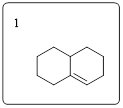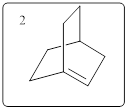
Organic Chemistry
7th Edition
ISBN: 9780321803221
Author: Paula Y. Bruice
Publisher: Prentice Hall
expand_more
expand_more
format_list_bulleted
Concept explainers
Question
Chapter 8, Problem 104P
Interpretation Introduction
Interpretation: In accordance with Bredt’s rule, it should be explained that why there cannot be a double bond at a bridgehead carbon atom.
Concept introduction:
- Bredt’s rule: This rule states that a bridged bicyclic compound cannot have a double bond at the bridgehead position unless one of the rings contains at least 8 carbon atoms.
According to this rule stable and unstable molecule is mentioned below,


The first compound is stable. Although double bond is at bridgehead, the system is not bridged
But the second compound is the good example to illustrate the violation of this rule. This compound is unstable because double bond is at bridgehead and ring contains only 6 carbons.
Expert Solution & Answer
Want to see the full answer?
Check out a sample textbook solution
Students have asked these similar questions
) Give the mechanism for the acid catalyzed hydrolysis of the following to the corresponding
carboxylic acid. Show all intermediates and resonance structures
N
H+,
H2O (excess)
# 2. Drow full structures of the organic product expected in each of the following reactions. Draw the
appropriate stereoisomer where warranted!
Tos Cl
O
C
NaCN
PCC
శ్రీ
CI
TSCI
Pyridine
H₂CrO4
PBrj
Pyridine
NaCN
PLEASE help. Locate a literature IR spectrum of eugenol. Insert the literature spectrum here:
What conclusions can you draw about your clove oil from these IR spectra? I attached my data below
Chapter 8 Solutions
Organic Chemistry
Ch. 8.1 - Prob. 1PCh. 8.1 - Prob. 2PCh. 8.4 - Prob. 3PCh. 8.5 - Prob. 5PCh. 8.6 - a. Predict the relative bond lengths of the three...Ch. 8.6 - Prob. 7PCh. 8.6 - Prob. 8PCh. 8.8 - Prob. 9PCh. 8.9 - Prob. 10PCh. 8.9 - Prob. 12P
Ch. 8.9 - Prob. 13PCh. 8.10 - Prob. 14PCh. 8.10 - What orbitals contain the electrons represented as...Ch. 8.10 - Prob. 16PCh. 8.10 - Prob. 17PCh. 8.11 - Prob. 18PCh. 8.11 - Prob. 19PCh. 8.11 - Prob. 20PCh. 8.12 - Prob. 21PCh. 8.12 - Prob. 22PCh. 8.12 - Prob. 23PCh. 8.13 - Prob. 24PCh. 8.13 - Prob. 25PCh. 8.13 - Prob. 26PCh. 8.14 - Prob. 27PCh. 8.14 - Prob. 28PCh. 8.14 - Prob. 29PCh. 8.15 - Which member of each pair is the stronger acid?Ch. 8.15 - Which member of each pair is the stronger base? a....Ch. 8.15 - Rank the following compounds from strongest acid...Ch. 8.15 - Prob. 34PCh. 8.16 - Prob. 35PCh. 8.17 - Prob. 37PCh. 8.17 - Prob. 38PCh. 8.17 - Prob. 39PCh. 8.17 - Prob. 40PCh. 8.17 - Prob. 41PCh. 8.17 - Prob. 42PCh. 8.18 - Prob. 43PCh. 8.18 - Prob. 44PCh. 8.18 - Prob. 45PCh. 8.18 - Prob. 47PCh. 8.19 - Prob. 48PCh. 8.19 - Prob. 49PCh. 8.19 - Prob. 50PCh. 8.19 - Prob. 51PCh. 8.19 - Prob. 52PCh. 8.19 - Prob. 53PCh. 8.19 - Prob. 55PCh. 8.20 - Prob. 56PCh. 8 - Prob. 57PCh. 8 - Prob. 58PCh. 8 - Prob. 59PCh. 8 - Prob. 60PCh. 8 - Prob. 61PCh. 8 - Prob. 62PCh. 8 - Prob. 63PCh. 8 - Prob. 64PCh. 8 - Prob. 65PCh. 8 - Prob. 66PCh. 8 - Prob. 67PCh. 8 - Prob. 68PCh. 8 - Prob. 69PCh. 8 - Which compound is the strongest base?Ch. 8 - Prob. 71PCh. 8 - Prob. 72PCh. 8 - Prob. 73PCh. 8 - Prob. 74PCh. 8 - Prob. 75PCh. 8 - Prob. 76PCh. 8 - Prob. 77PCh. 8 - Prob. 78PCh. 8 - Purine is a heterocyclic compound with four...Ch. 8 - Prob. 80PCh. 8 - Why is the delocalization energy of pyrrole (21...Ch. 8 - Prob. 82PCh. 8 - Prob. 83PCh. 8 - Prob. 84PCh. 8 - A student obtained two products from the reaction...Ch. 8 - Prob. 86PCh. 8 - a. How could each of the following compounds be...Ch. 8 - Draw the products obtained from the reaction of...Ch. 8 - How would the following substituents affect the...Ch. 8 - Prob. 90PCh. 8 - The acid dissociation constant (Ka) for loss of a...Ch. 8 - Protonated cyclohexylamine has a Ka = 1 1011...Ch. 8 - Prob. 93PCh. 8 - Prob. 94PCh. 8 - Prob. 95PCh. 8 - Prob. 96PCh. 8 - Prob. 97PCh. 8 - a. Propose n mechanism for the following reaction:...Ch. 8 - Prob. 99PCh. 8 - As many as 18 different Diels-Alder products can...Ch. 8 - Prob. 101PCh. 8 - Prob. 102PCh. 8 - Prob. 103PCh. 8 - Prob. 104PCh. 8 - The experiment shown next and discussed in Section...Ch. 8 - Prob. 106PCh. 8 - Prob. 107PCh. 8 - Prob. 108PCh. 8 - Prob. 1PCh. 8 - Prob. 2PCh. 8 - Prob. 3PCh. 8 - Prob. 4PCh. 8 - Prob. 5PCh. 8 - Prob. 6PCh. 8 - Prob. 7PCh. 8 - Prob. 8PCh. 8 - Prob. 9PCh. 8 - Prob. 10PCh. 8 - Prob. 11PCh. 8 - Prob. 12P
Knowledge Booster
Learn more about
Need a deep-dive on the concept behind this application? Look no further. Learn more about this topic, chemistry and related others by exploring similar questions and additional content below.Similar questions
- please help and the percent recovery of clove oil from cloves is 4.61% and i have attached my ir spectrum as well. Based on your GC data, how many components are in the clove oil? Calculate the percentage of each component. Clearly show your work. Which of the components corresponds to eugenol? How do you know? Is eugenol the major component?arrow_forwardplease help and i am so confused if the picture is the gc data or ir spectrum. you dont have to do everything just what you can please because i am lost and the mass of the cloves was Mass of cloves 62.299g. Mass of recovered clove oil 62.761g.arrow_forwardWhich compound would you expect to have a higher decomposition temperature,Na2CO3 or Cs2CO3? Justify your answer, but you do not need to do any calculations.arrow_forward
- Can I get helpp drawing my arrowsarrow_forwardWhich of the m/z values corresponds to the base peak in the mass spectrum shown? 100 80 A. 45 B. 44 C. 29 D. 15 Intensity 20 0 10 20 30 40 B- m/z -8 50 E. 30 Which of the m/z values correspond to the molecular ion for the compound shown? A. 18 B. 82 OH C. 100 D. 102 E. 103arrow_forwardCan someone help me with drawing my arrows.arrow_forward
arrow_back_ios
SEE MORE QUESTIONS
arrow_forward_ios
Recommended textbooks for you
 Organic ChemistryChemistryISBN:9781305580350Author:William H. Brown, Brent L. Iverson, Eric Anslyn, Christopher S. FootePublisher:Cengage Learning
Organic ChemistryChemistryISBN:9781305580350Author:William H. Brown, Brent L. Iverson, Eric Anslyn, Christopher S. FootePublisher:Cengage Learning Introductory Chemistry: An Active Learning Approa...ChemistryISBN:9781305079250Author:Mark S. Cracolice, Ed PetersPublisher:Cengage Learning
Introductory Chemistry: An Active Learning Approa...ChemistryISBN:9781305079250Author:Mark S. Cracolice, Ed PetersPublisher:Cengage Learning
 Chemistry for Today: General, Organic, and Bioche...ChemistryISBN:9781305960060Author:Spencer L. Seager, Michael R. Slabaugh, Maren S. HansenPublisher:Cengage Learning
Chemistry for Today: General, Organic, and Bioche...ChemistryISBN:9781305960060Author:Spencer L. Seager, Michael R. Slabaugh, Maren S. HansenPublisher:Cengage Learning Organic Chemistry: A Guided InquiryChemistryISBN:9780618974122Author:Andrei StraumanisPublisher:Cengage Learning
Organic Chemistry: A Guided InquiryChemistryISBN:9780618974122Author:Andrei StraumanisPublisher:Cengage Learning

Organic Chemistry
Chemistry
ISBN:9781305580350
Author:William H. Brown, Brent L. Iverson, Eric Anslyn, Christopher S. Foote
Publisher:Cengage Learning

Introductory Chemistry: An Active Learning Approa...
Chemistry
ISBN:9781305079250
Author:Mark S. Cracolice, Ed Peters
Publisher:Cengage Learning


Chemistry for Today: General, Organic, and Bioche...
Chemistry
ISBN:9781305960060
Author:Spencer L. Seager, Michael R. Slabaugh, Maren S. Hansen
Publisher:Cengage Learning

Organic Chemistry: A Guided Inquiry
Chemistry
ISBN:9780618974122
Author:Andrei Straumanis
Publisher:Cengage Learning